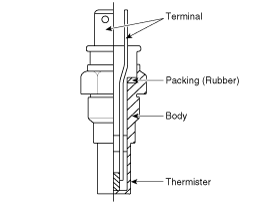Hyundai Tucson: Engine Control System / Engine Coolant Temperature Sensor (ECTS) Description and Operation
Hyundai Tucson (LM) 2010-2015 Service Manual / Engine Control / Fuel System / Engine Control System / Engine Coolant Temperature Sensor (ECTS) Description and Operation
| Description |
Engine Coolant Temperature Sensor (ECTS) is located in the
engine coolant passage of the cylinder head for detecting the engine
coolant temperature. The ECTS uses a thermistor that changes resistance
with the temperature.
The electrical resistance of the ECTS decreases as the
temperature increases, and increases as the temperature decreases. The
reference +5V is supplied to the ECTS via a resistor in the ECM. That
is, the resistor in the ECM and the thermistor in the ECTS are connected
in series. When the resistance value of the thermistor in the ECTS
changes according to the engine coolant temperature, the output voltage
also changes.
During cold engine operation, the ECM increases the fuel
injection duration and controls the ignition timing using the
information of engine coolant temperature to avoid engine stalling and
improve drivability.

 Intake Air Temperature Sensor (IATS) Repair procedures
Intake Air Temperature Sensor (IATS) Repair procedures
Inspection
1.
Turn the ignition switch OFF.
2.
Disconnect the IATS connector.
3.
Measure resistance between the IATS terminals 3 and 4.
4.
Check that the resistance is within the speci ...
 Engine Coolant Temperature Sensor (ECTS) Specifications
Engine Coolant Temperature Sensor (ECTS) Specifications
Specification
TemperatureResistance (kx)°C°F-40-4048.14-20-414.13 ~ 16.830325.7920682.31 ~ 2.59401041.15601400.59801760.32
...
Other information:
Hyundai Tucson (LM) 2010-2015 Service Manual: Camshaft Repair procedures
Removal
Timing chain cover removal is not required for this procedure.
•
Use fender covers to avoid damaging painted surfaces.
•
To avoid damage, unplug the wiring connectors carefully while holding the connector portion.
•
Mar ...
Hyundai Tucson (LM) 2010-2015 Service Manual: 4WD ECU Description and Operation
Description
4WD ECU processes signals from various sensors and determines
the current road and driving conditions. The ECU then utilizes this
information to implement precision control over the 4WD coupling's
multi-plate clutch and variably adjust the amount of torque delivered
tothe rear ...
© 2010-2025 www.htmanual.net
